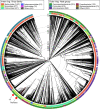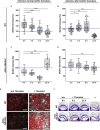Isolation and Characterization of Shewanella Phage Thanatos Infecting and Lysing Shewanella oneidensis and Promoting Nascent Biofilm Formation
- PMID: 33072035
- PMCID: PMC7530303
- DOI: 10.3389/fmicb.2020.573260
Isolation and Characterization of Shewanella Phage Thanatos Infecting and Lysing Shewanella oneidensis and Promoting Nascent Biofilm Formation
Abstract
Species of the genus Shewanella are widespread in nature in various habitats, however, little is known about phages affecting Shewanella sp. Here, we report the isolation of phages from diverse freshwater environments that infect and lyse strains of Shewanella oneidensis and other Shewanella sp. Sequence analysis and microscopic imaging strongly indicate that these phages form a so far unclassified genus, now named Shewanella phage Thanatos, which can be positioned within the subfamily of Tevenvirinae (Duplodnaviria; Heunggongvirae; Uroviricota; Caudoviricetes; Caudovirales; Myoviridae; Tevenvirinae). We characterized one member of this group in more detail using S. oneidensis MR-1 as a host. Shewanella phage Thanatos-1 possesses a prolate icosahedral capsule of about 110 nm in height and 70 nm in width and a tail of about 95 nm in length. The dsDNA genome exhibits a GC content of about 34.5%, has a size of 160.6 kbp and encodes about 206 proteins (92 with an annotated putative function) and two tRNAs. Out of those 206, MS analyses identified about 155 phage proteins in PEG-precipitated samples of infected cells. Phage attachment likely requires the outer lipopolysaccharide of S. oneidensis, narrowing the phage's host range. Under the applied conditions, about 20 novel phage particles per cell were produced after a latent period of approximately 40 min, which are stable at a pH range from 4 to 12 and resist temperatures up to 55°C for at least 24 h. Addition of Thanatos to S. oneidensis results in partial dissolution of established biofilms, however, early exposure of planktonic cells to Thanatos significantly enhances biofilm formation. Taken together, we identified a novel genus of Myophages affecting S. oneidensis communities in different ways.
Keywords: LPS; Shewanella; adhesion; biofilm; lysis; phage.
Copyright © 2020 Kreienbaum, Dörrich, Brandt, Schmid, Leonhard, Hager, Brenzinger, Hahn, Glatter, Ruwe, Briegel, Kalinowski and Thormann.
Figures







Similar articles
-
Phage-induced lysis enhances biofilm formation in Shewanella oneidensis MR-1.ISME J. 2011 Apr;5(4):613-26. doi: 10.1038/ismej.2010.153. Epub 2010 Oct 21. ISME J. 2011. PMID: 20962878 Free PMC article.
-
Isolation and characterization of virulent phages infecting Shewanella baltica and Shewanella putrefaciens, and their application for biopreservation of chilled channel catfish (Ictalurus punctatus).Int J Food Microbiol. 2019 Mar 2;292:107-117. doi: 10.1016/j.ijfoodmicro.2018.12.020. Epub 2018 Dec 21. Int J Food Microbiol. 2019. PMID: 30594742
-
Transcriptome analysis of early surface-associated growth of Shewanella oneidensis MR-1.PLoS One. 2012;7(7):e42160. doi: 10.1371/journal.pone.0042160. Epub 2012 Jul 31. PLoS One. 2012. PMID: 22860070 Free PMC article.
-
A Novel Benthic Phage Infecting Shewanella with Strong Replication Ability.Viruses. 2019 Nov 19;11(11):1081. doi: 10.3390/v11111081. Viruses. 2019. PMID: 31752437 Free PMC article.
-
Tale of two metal reducers: comparative proteome analysis of Geobacter sulferreducens PCA and Shewanella oneidensis MR-1.Methods Biochem Anal. 2006;49:97-111. Methods Biochem Anal. 2006. PMID: 16929676 Review.
Cited by
-
An autonomous plasmid as an inovirus phage satellite.Appl Environ Microbiol. 2024 May 21;90(5):e0024624. doi: 10.1128/aem.00246-24. Epub 2024 Apr 10. Appl Environ Microbiol. 2024. PMID: 38597658 Free PMC article.
-
Reduction of selenite and tellurite by a highly metal-tolerant marine bacterium.Int Microbiol. 2024 Feb;27(1):203-212. doi: 10.1007/s10123-023-00382-w. Epub 2023 Jun 1. Int Microbiol. 2024. PMID: 37261581
-
Identifying components of the Shewanella phage LambdaSo lysis system.J Bacteriol. 2024 Jun 20;206(6):e0002224. doi: 10.1128/jb.00022-24. Epub 2024 May 21. J Bacteriol. 2024. PMID: 38771038 Free PMC article.
-
A Novel Polyvalent Bacteriophage vB_EcoM_swi3 Infects Pathogenic Escherichia coli and Salmonella enteritidis.Front Microbiol. 2021 Jul 14;12:649673. doi: 10.3389/fmicb.2021.649673. eCollection 2021. Front Microbiol. 2021. PMID: 34335489 Free PMC article.
-
Bacterial isolation and genome analysis of a novel Klebsiella quasipneumoniae phage in southwest China's karst area.Virol J. 2024 Mar 6;21(1):56. doi: 10.1186/s12985-024-02321-1. Virol J. 2024. PMID: 38448926 Free PMC article.
References
-
- Adams M. (1959). Bacteriophages. New York, NY: Interscience Publishers.
LinkOut - more resources
Full Text Sources
Miscellaneous

